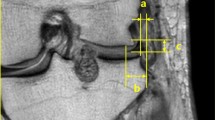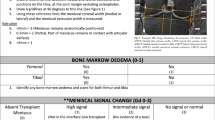Abstract
Purpose
To evaluate the serial change of magnetic resonance imaging (MRI) signal intensity (SI) of lateral meniscal allografts in a long-term period of > 8 years and to determine whether the SI change adversely affected clinical outcomes.
Methods
Thirty-three lateral meniscal allograft transplantation (LMAT) patients with MRI taken > 8 years after surgery were included. The allograft was assessed using MRI at five serial time points (1, 2–4, 4–6, 6–8, and > 8 years after surgery), based on the following grading system: grade 1, globular increased SI not adjacent to the articular surface; grade 2, linear SI within the meniscus; and grade 3, increased SI extended to the articular surface. MRI evaluation was performed for three locations of the allograft (anterior horn, mid-body, and posterior horn), and the serial changes of allograft SI at each location were analyzed using the generalized estimating equation (GEE) with cumulative logit link function. The patients were classified according to SI change at each location (stationary group and deterioration group), and the two groups were compared in terms of clinical outcomes using the Lysholm score.
Results
The mean follow-up duration was 9.2 ± 1.2 years. During that period, SI of the allograft deteriorated over time, regardless of the location (anterior horn, p = 0.034; mid-body, p = 0.002; posterior horn, p < 0.001). The amount of SI deterioration at each location of the graft differed with a borderline significance (p = 0.050, GEE), and the proportion of grade 3 SI was higher at the posterior horn (36.4%) than at the other locations at the last follow-up (p < 0.001, chi-square test). However, no significant differences in the Lysholm scores were found between the stationary group and the deterioration group at all locations.
Conclusion
SI of the meniscal allograft deteriorated over time at all locations during the long-term follow-up. Deterioration of the graft was more prominent at the posterior horn than at the other locations. SI deterioration did not adversely affect the clinical outcomes, which should be interpreted with caution, considering the small sample size of this study. In the prognosis of lateral MAT, SI deterioration at the posterior horn is a more determining factor than that at the other part of the allograft. Therefore, SI at the posterior horn needs to be examined with special concern.
Level of evidence
III.




Similar content being viewed by others
References
Cavendish AP, DiBartola AC, Everhart JS, Kuzma S, Kim WJ, Flanigan DC (2020) Meniscal allograft transplantation: a review of indications, techniques, and outcomes. Knee Surg Sports Traumatol Arthrosc 28:3539–3550
Brial C, McCarthy M, Adebayo O, Wang H, Chen T, Warren R, Maher S (2019) Lateral meniscal graft transplantation: effect of fixation method on joint contact mechanics during simulated gait. Am J Sports Med 47:2437–2443
Dianat S, Small KM, Shah N, Lattermann C, Mandell JC (2021) Imaging of meniscal allograft transplantation: what the radiologist needs to know. Skeletal Radiol 50:615–627
DiBartola AC, Rogers A, Kurzweil P, Knopp MV, Flanigan DC (2021) In-office needle arthroscopy can evaluate meniscus tear repair healing as an alternative to magnetic resonance imaging. Arthrosc Sports Med Rehabil 3:e1755–e1760
Fanelli D, Mercurio M, Gasparini G, Galasso O (2021) Predictors of meniscal allograft transplantation outcome: a systematic review. J Knee Surg 34:303–321
Gilat R, Cole BJ (2020) Meniscal allograft transplantation: indications, techniques, outcomes. Arthroscopy 36:938–939
Kim J-M, Lee B-S, Kim K-H, Kim K-A, Bin S-I (2012) Results of meniscus allograft transplantation using bone fixation: 110 cases with objective evaluation. Am J Sports Med 40:1027–1034
Lee D-H, Lee B-S, Chung J-W, Kim J-M, Yang K-S, Cha E-J, Bin S-I (2011) Changes in magnetic resonance imaging signal intensity of transplanted meniscus allografts are not associated with clinical outcomes. Arthroscopy 27:1211–1218
Noyes FR, Barber-Westin SD (2016) Long-term survivorship and function of meniscus transplantation. Am J Sports Med 44:2330–2338
Park J-G, Bin S-I, Kim J-M, Lee B-S, Lee S-M, Song J-H (2021) Increased MRI signal intensity of allografts in the midterm period after meniscal allograft transplant: an evaluation of clinical significance according to location and morphology. Orthop J Sports Med 9:23259671211033600
Ren S, Zhang X, Yu X, Zhou R, Xu L, Lin Z, Zhang W (2020) Correlation analysis of potential factors influencing graft maturity based on MRI after lateral meniscal allograft transplantation. Sci Rep 10:11250
Searle H, Asopa V, Coleman S, McDermott I (2020) The results of meniscal allograft transplantation surgery: what is success? BMC Musculoskelet Disord 21:159
Song J-H, Bin S-I, Kim J-M, Lee B-S (2021) Meniscal allograft transplantation shows a mismatch between anatomic and clinical failures. Knee Surg Sports Traumatol Arthrosc 30:1700–1705
Song J-H, Bin S-I, Kim J-M, Lee B-S (2020) Postoperative subchondral bone marrow lesion is associated with graft extrusion after lateral meniscal allograft transplantation. Am J Sports Med 48:3163–3169
Stevenson C, Mahmoud A, Tudor F, Myers P (2019) Meniscal allograft transplantation: undersizing grafts can lead to increased rates of clinical and mechanical failure. Knee Surg Sports Traumatol Arthrosc 27:1900–1907
Verdonk PCM, Verstraete KL, Almqvist KF, De Cuyper K, Veys EM, Verbruggen G, Verdonk R (2006) Meniscal allograft transplantation: long-term clinical results with radiological and magnetic resonance imaging correlations. Knee Surg Sports Traumatol Arthrosc 14:694–706
van der Wal RJP, Nieuwenhuijse MJ, Spek RWA, Thomassen BJW, van Arkel ERA, Nelissen RGHH (2020) Meniscal allograft transplantation in The Netherlands: long-term survival, patient-reported outcomes, and their association with preoperative complaints and interventions. Knee Surg Sports Traumatol Arthrosc 28:3551–3560
Wang W, Li Z, Peng H-M, Bian Y-Y, Li Y, Qian W-W, Weng X-S, Jin J, Yang X-Y, Lin J (2021) Accuracy of MRI diagnosis of meniscal tears of the knee: a meta-analysis and systematic review. J Knee Surg 34:121–129
Waugh N, Mistry H, Metcalfe A, Loveman E, Colquitt J, Royle P, Smith NA, Spalding T (2019) Meniscal allograft transplantation after meniscectomy: clinical effectiveness and cost-effectiveness. Knee Surg Sports Traumatol Arthrosc 27:1825–1839
Zaffagnini S, Grassi A, Romandini I, Marcacci M, Filardo G (2019) Meniscal allograft transplantation combined with anterior cruciate ligament reconstruction provides good mid-term clinical outcome. Knee Surg Sports Traumatol Arthrosc 27:1914–1923
Funding
No funding was received for this study.
Author information
Authors and Affiliations
Corresponding author
Ethics declarations
Conflict of interest
Each author certifies that he or she has no commercial associations that might pose a conflict of interest in connection with the submitted article.
Ethical committee approval
This study was approved by our institutional review board (approval no. 2020-1641).
Additional information
Publisher's Note
Springer Nature remains neutral with regard to jurisdictional claims in published maps and institutional affiliations.
Rights and permissions
Springer Nature or its licensor holds exclusive rights to this article under a publishing agreement with the author(s) or other rightsholder(s); author self-archiving of the accepted manuscript version of this article is solely governed by the terms of such publishing agreement and applicable law.
About this article
Cite this article
Song, JH., Bin, SI., Kim, JM. et al. Signal intensity of lateral meniscal allografts deteriorates over time: a longitudinal MRI analysis during a minimum follow-up of 8 years. Knee Surg Sports Traumatol Arthrosc 31, 503–509 (2023). https://doi.org/10.1007/s00167-022-07069-1
Received:
Accepted:
Published:
Issue Date:
DOI: https://doi.org/10.1007/s00167-022-07069-1




